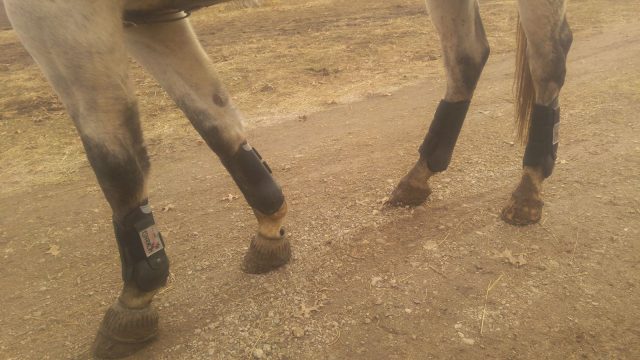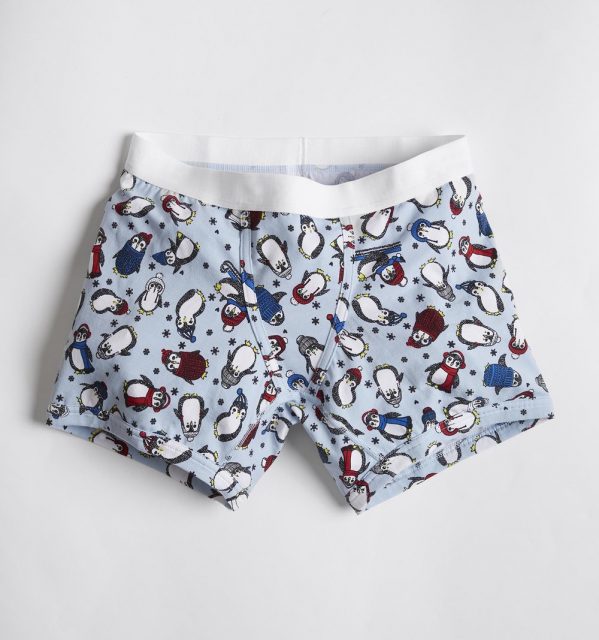It’s a hard pill to swallow when a clinician tells you what you NEED to hear … not what you want to hear. After day 1 of the Buck Davidson clinic in Kansas City earlier this month, I considered chickening out, packing up and driving home. Self-doubt crept in: “Should I even bother with day 2?” I FAILED on day 1. I plotted how we could just load up after everyone left, and drive home.
But I didn’t. I stayed. I dusted myself off and checked my ego at the door. Why? I came to the clinic to ride with Buck Davidson because I don’t have all the answers. So it would be foolish to leave after he gave me answers, simply because I didn’t like them. “Your horse is doing exactly what you’re telling him. He’s running because of YOU; he’s stalling at the jumps because of YOU.” It was like I had been stabbed in the heart. Surely this internationally known, successful team rider was wrong. Surely it’s not my fault.

Riding with Buck Davidson.
The clinic started like most others I’ve attended — George Morris, Dom and Jimmie Schramm, Leslie Law, Peter Trappmann — you introduce yourself and your horse, say a little bit about what you are working on and where you want to go. I tend to be overly honest at this stage. When others tell of their placings and accolades, I declare our “Hotmess Express” title with the hopes of finally improving. I have several horses on which I compete in eventing, and I have trained dozens of horses from track/rescue/unbroke to successful event horse. I have ribbons and championships in jumpers and eventing to my credit, including invitations with several horses to the American Eventing Championships up to Training Level. None of that mattered, so I bit my tongue.
I was here because I desperately needed help with my $1,000 Craigslist find, a spirited, complicated, grey OTTB named Hummingbird’s River. This grey dinosaur has been hands down THE most challenging horse to train and compete in my 26 years of riding. I was eager for Buck to take a look and help us. HELP. US.
I compare it to a car — your car makes a thumping noise when you drive, so you take it to a mechanic. It stops thumping. They can’t help you because they can’t find the problem, so the problem persists. Lucky for me (sarcasm dripping here), our problems were so apparent that by the end of day 1 I actually discussed with my husband the option of packing up and leave, that I couldn’t cut it, and that I should not participate in day 2. That maybe River would be better suited as a trail horse? Maybe third flight fox hunter?
I have never come so close to legitimately crying in the middle of a clinic in all my life (I generally save my tears for River’s stall, where they belong). Wasn’t it great that our problems were blatantly obvious on day 1 so Buck could help?

Amy Nelson & Hummingbird’s River.
Chapter 1: The Truth Hurts
Buck repeated several times that the whole point of clinics and lessons are so you could “FEEL” the concept. He stressed that you could read books and tips all day long, but until you felt it, you could never master it. It was in this nugget of wisdom that he had me change out the bit I was using. A stronger bit had been suggested to me by a trainer who has seen River in action, we have used it for several rides and I figured I would use it in the clinic. A after 10 minutes of watching us struggle over fences, Buck made me switch to a snaffle.
I was skeptical (OK scared) at first, as this is a horse who has jumped up a 5-foot embankment into trees and bushes after a crossrail when I was trying to stop on a straight line. This is a horse who bolted in dressage last summer and got us the “E” when he jumped out of the dressage ring! But I didn’t pay to be in a clinic with a rider of Buck’s caliber to let my pride get in the way of learning. So … in went the snaffle.
Then, horror upon horrors, Buck singled me out in front of the entire Midwest Eventing Community (or what felt like it) and explained that my psycho grey and I needed connection. He told everyone, including me, that a short rein is a must to keep such connection. He essentially had us two-point, feel the horse’s mouth, and touch our elbows in front of our bodies (chest area). THAT is how long your reins should be, he explained.
The biggest thing in riding is for the horse to trust your hand. If they are not on the bit, they are just as disobedient as a horse running off (I perked up at this part). River has run off loads of times! The horse needs to accept your hand and leg, and really, horses don’t rush the fences — people do.

Amy Nelson & Hummingbird’s River.
Chapter 2: Baby Steps
The remainder of day 1 seemed to be a constant reminder of how everything we did as a team was my fault, and how I needed to make huge changes to fix everything. As a trainer, I had very mixed emotions on this. River and I have four years of tumultuous history together. I got him straight off the track from an ad on Craigslist, and to say he has issues an understatement. We did the Thoroughbred Makeover in 2015 where judges described him (yes, I rode him in a snaffle then) as VERY VERY BOLD and A LITTLE TOO KEEN. We finished mid-pack.
But in the midst of the struggle-bus that day 1 presented, I compared it to one of those extreme weight loss TV shows. Let’s say we started out 600 pounds. We lost 200 pounds — wow amazing — we are so thin! But to the world we are still 400 pounds, which is NOT thin. I was starting to see Buck Davidson’s point of view. We have come so far … but certainly have not arrived. The end of the session brought baby steps of improvement with microscopic victories. We had ounces of connection and a glimmer of hope when he didn’t actually run face-first into the viewing area window a fifth time (the previous four times led to viewers behind the plexiglass diving out of the way).
But really, should I even show up on the second day? Were we ready as a team to simply stay in the same clinic group? Would they quietly ask me to move down a level?

Amy Nelson & Hummingbird’s River
Chapter 3: I Put on My Big Girl Panties and SHOWED UP
I’ll be honest, I went to bed that night not knowing if I was actually going to ride the second day. Self-doubt, fear, and overwhelming emotions kept me up most of the night. But by morning, I had a new determination. I went through my pages of notes I had taken throughout day one of the clinic while auditing the other groups. Several fell off. Several were almost in tears. Several needed major help and improvement. I was not alone with my struggles, and the whole point of going was NOT to have Buck tell me how amazing I am and lie to my face. The point was to get help. I tacked up, put in a snaffle, chin up, here we go.

Amy Nelson & Hummingbird’s River with Buck Davidson
Chapter 4: Something Changed
Day 2 was hands down the best experience of my riding career. River and I were starting to be a TEAM — not a well-oiled machine, but pieces and parts were coming together. I noticed Buck seemed to have a new attitude towards me as well. Simply by showing up in a snaffle, prepared to learn, asking questions and doing what he said in spite of how scary it was (he literally had me SIT an entire sizable jump course — no two point allowed) proved to him I could be instructed. I could take direction. I wanted to improve. And he was right about his statement from the first day — I FELT SOMETHING.
In sitting our entire course, I felt the base of the jump with my horse in my hand. I felt that connection. We were starting to leave every single fence UP! We did the Circle of Death almost easily, with my legs on and a short rein, turning in the air to our next fence.
We were starting to have pace! The first day he announced that to have a good jump you need three things: pace, balance and distance — and if you have two of the three, your third will be there. River and I never have pace. We dabble somewhere between fighting in place (picture a snarling, rabid wolverine with a death-grip on its face) and “his tail is on fire and we are all out running to the nearest hydrant.” Buck kept yelling, “Gallop him! Go on! Faster!” Excuse me, what? I have literally never heard this before with this horse. Now that we were working in together, we were cantering softly, and too slow!

Photo courtesy of Amy Nelson.
Conclusion: Be Humble
The Buck Davidson clinic at West End Farm in Kansas City, put on by Twin Pony Productions, was absolutely the most challenging, most rewarding, most frustrating, most eye-opening educational experience of my career. Do the clinic. FEEL. Don’t give up — but put on your big girl panties. Everyone assumes George Morris is tough, but Buck tells it like it is and makes George look like a sweet kitten. Buck hit me where it hurt the most: the truth about flaws in my riding.
Buckisms – Nuggets of Wisdom:
- Be CLEAR in your direction.
- Be ENCOURAGING in all your training.
- Horses aren’t that smart but they have a great memory. Do it even if it’s not perfect the first time, because it only gets harder from there (i.e. don’t go around the jump by accident, make them stay straight, stop on a straight line, etc.).
- Keep your reins short — maintain connection.
- The key to riding is to have something so engrained in them that it’s repeatable.
- Your shoulders should be parallel to their shoulders.
- Your nose should always line up with their mane. Don’t lean.
- In dressage — Get a good score on the first movement down the centerline. Judges are human. If you are getting 6s and they miss a movement, you get a 6 because they think that’s what you probably did.
- Show jumping is just dressage over jumps.
- If you fail to prepare you prepare to fail.
- Get your horse going!
- What’s the definition of insanity? Repeating the same thing and expecting a different result.
- Use the jump as a second set of reins.
- If you have a good seat you shouldn’t need to touch your reins. You don’t slow a horse down with your reins, you slow them down with your core. If you can’t do that, you need more core.
- In practice — “find the line.” The line of what you’re good at, how tight they can turn, how fast they can gallop without going psycho. Then you know where the line is BEFORE you go to the show. At the show, remember where the line is. Go right up to it, but don’t cross it.
Ride in clinics. Feel. Don’t be afraid to fail in front of your peers. It will only make you better.
3 … 2 … 1 … have an educational ride.




















































































































